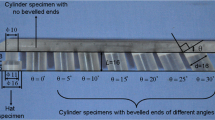Abstract
Polymethyl methacrylate(PMMA) is a kind of typical viscoelastic polymer materials, whose deformation and rheologic fracture are related not only with time and temperature, but also with strain rate on loading. By the quasi-static uniaxial tension test at defferent loading rates, the strain-rate-dependent stress-time equation of PMMA material was gotten with H-K mode. In the range of given strain rates, tes, E 2(\(\dot \varepsilon \)) is almost not varied with strain rate, but E 1(\(\dot \varepsilon \)) and η1(\(\dot \varepsilon \)) augment with strain rate reducing, which shows that viscosity of PMMA material responds more strongly; whereas, they reduce with strain rate increasing, which shows that the viscosity of PMMA material responds more feebly; when the strain rate is added up to infinite, E 1(\(\dot \varepsilon \)) goes to constant and η1(\(\dot \varepsilon \)) to naught, which shows that PMMA material responds elasticity by constitutive mode. Based on the theory of continuum mechanics, median stress is defined as the ratio of fracture strain energy density to fracture strain, according to the energy conservation law and Cauchy median law. The median stress of PMMA is not related with strain rate in the range of the given strain rates, so it is represented as a parameter to scale the fracture of PMMA.
Similar content being viewed by others
References
LU Xi-ci. Macromolecular Materials Strength and Destruction[M]. Chengdu: Sichuan Education Press, 1988.(in Chinese)
NARISAWA I, YEE A F. Crazing and fracture of polymers[C]// Thomas E L ed. Structure and Properties of Polymers, Materials Science and Technology, A comprehensive Treatment. 1993, 12: 698–765.
LUO Wen-bo, YANG Ting-qing, ZHANG Ping. An extensive on meso-damage evolution in polymers[J]. Advances in Mechanics, 2001, 31(2): 264–275. (in Chinese)
GILLEMOT L F. Criterionof crack ignition and spreading[J]. Engng Fract Mech, 1976, 8: 239–253.
KAUSCH H H. Crazing in polymers[M]//Advances in Polymer Science 91/92. Berlin: Springer-Verlag, 1990.
YU Jie, JIN Zhi-hao, ZHOU Hui-jiu. Initiation mechanism and criterion of craze[J]. Polymer Material Science and Engineering, 1997, 13: 98–103. (in Chinese)
SHA Y, HUI C Y, RUINA A, et al. Detailed simulation of craze fibril failure at a crack tip in a glassy polymer[J]. Acta Mater, 1997, 45(9): 3555–3563.
ZHANG Chun-yuan. Viscoelastic Rupture Mechanics[M]. Wuhan: Huazhong University of Science and Technology Press, 1994. (in Chinese)
LI Q M. Strain energy density failure criterion[J]. International Journal of Solids and Structures, 2001, 38: 6997–7013.
Author information
Authors and Affiliations
Corresponding author
Rights and permissions
About this article
Cite this article
Sun, Y. Rheologic fracture of PMMA material at different strain rates. J Cent. South Univ. Technol. 14 (Suppl 1), 342–345 (2007). https://doi.org/10.1007/s11771-007-0278-7
Published:
Issue Date:
DOI: https://doi.org/10.1007/s11771-007-0278-7




